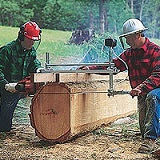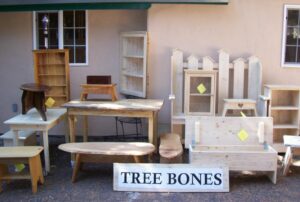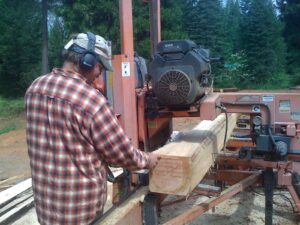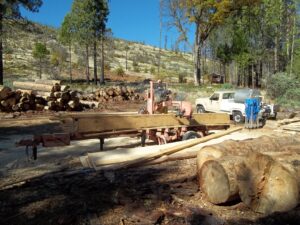Making lumber since 1995
Experience
The skills required to produce quality lumber take time and experience to acquire. As the saying goes; You can learn how to operate a sawmill in one day, but it takes years to learn how to become a good Sawyer. As for myself, starting in 1995, it took me five years of working as a carpenter to pay off my sawmill, and during this time I butchered many nice logs learning how to be good at what I do.
Recently on one of my jobs, I saw first hand how an inexperienced mill operator spent a full week trying to mill what I was able process in one day, and the waste pile left behind amounted to a significant loss to the log owner. Don’t get me wrong, I have been there myself. The owner of those Redwood logs said to me, “I am impressed and very happy with your skills“. Years of experience are worth taking a good look at when choosing a competent Sawyer.
My Sawmill Story
Firewood
Long before purchasing a brand new 1995 Wood-Mizer sawmill I cut a lot of firewood. Realizing the value of logs that could be made into lumber instead of firewood I got myself an inexpensive Alaskan mill attachment for my chainsaw and made my first boards, slabs and beams.

Woodworking
Building furniture and many small projects became a full time job, along with the construction trade. This called for larger quantities of lumber. Chainsaw milling is a slow going, labor intensive process when making lumber. This turned into a time consuming effort and I needed to produce more boards at a faster and easier pace.

Wood-Mizer LT40HD
In 1995 I purchased the Wood-Mizer LT40HD. At that time it was the top of the line sawmill that they made , the Cadillac of portable sawmills. It took some big hoop jumping to get it but I managed with the help from a couple friends. This is when I began learning how much information was needed to produce quality lumber.
I found out the hard way that it takes more than just having the proper tools. It requires a level of skill that comes both from trial and error and research into different cutting methods, species for trees and lumber itself.

Learning Curve
It takes many hours of cutting logs into cants, learning how to size up and grade logs before putting them onto the mill and making a few mistakes along the way to gain the skills needed to become good at being a professional Sawyer.
Knowledge of how to operate the controls of the sawmill and the different cutting methods isn’t enough by itself. It takes a great many hours of sawing logs to perfect the skills of a good sawyer. Learning how to grade logs before putting them onto the mill and making the opening cuts that will determine the final quality and volume of lumber produced from each log is not something that happens overnight.
It took five years of working as a carpenter to pay off the mill. During this time I did my fair share of butchering some nice logs. Learning to use the Wood-Mizer LT 40 HD sawmill was a multi year process enabling me to fine tune my skills as a professional Sawyer. Since those early days I have milled over one and a half million board feet of lumber.

Quality Service
Working closely with landowners, I strive to produce the highest quality lumber possible from your trees. Providing portable sawmill service’s at small one day jobs for homeowners to large commercial developments for weeks or months at a time. I can turn your logs into valuable lumber for construction, fencing or hardwood flooring and trim. If you have the trees, I’ll make the lumber.
Yes, I Know My Stuff!
I am a proud member of the Wood-Mizer Million Board Foot Club and the Pro Sawyer network. Milling over one and a half million board feet of lumber throughout my sawmilling time, I have developed the skills and have the experience to take your project to the next level.
Call now for a free quote, (209) 586-1250